2021 Honda CR-V Review: Hybrid Efficiency with SUV Utility
A CR-V Hybrid is competitively priced, and is reasonably thrifty with gas.
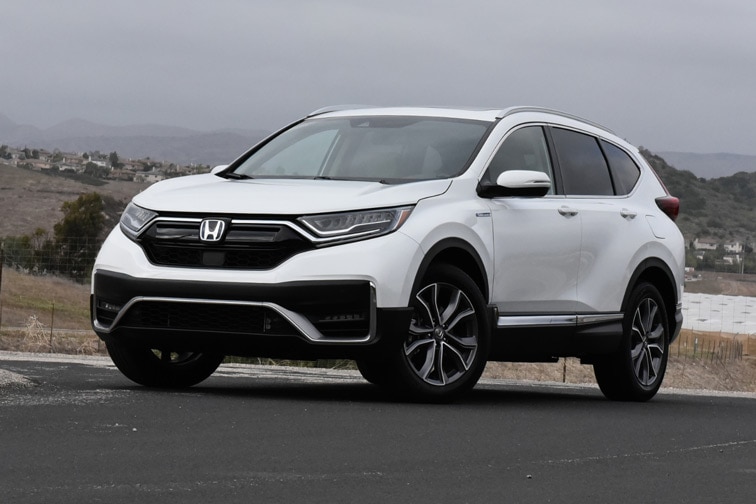 Christian Wardlaw
Christian WardlawHonda’s best-selling car isn’t a car at all. It’s a crossover SUV, and it goes by the name CR-V. Introduced for the 1997 model year, the Compact Recreational Vehicle is historically popular for its affordability, efficiency, utility, and dependability. Now, almost 25 years later, the 2021 Honda CR-V continues offering the traits that originally made it so popular.
Honda sells the 2021 CR-V in LX, Special Edition, EX, EX-L, and Touring trim levels. A CR-V Hybrid is also available and comes in all but LX and SE trim. Prices range from about $26,500 to $37,750, not including destination charges.
This year, the Special Edition trim level is new. Based on the standard LX trim, the CR-V Special Edition adds an upgraded infotainment system with a 7-inch touchscreen display, smartphone integration, text-messaging support, a basic connected services plan, and two extra stereo speakers for a total of six.
This version also comes with dual-zone automatic climate control, heated front seats, heated side mirrors, hands-free keyless entry, walk-away automatic locking, and remote engine starting. It will cost you $1,200 more over the base LX trim for the new CR-V Special Edition.
For this review, Honda provided a 2021 CR-V Hybrid Touring with extra-cost Platinum White Pearl paint. The sticker price came to $37,920 including the $1,175 destination charge.
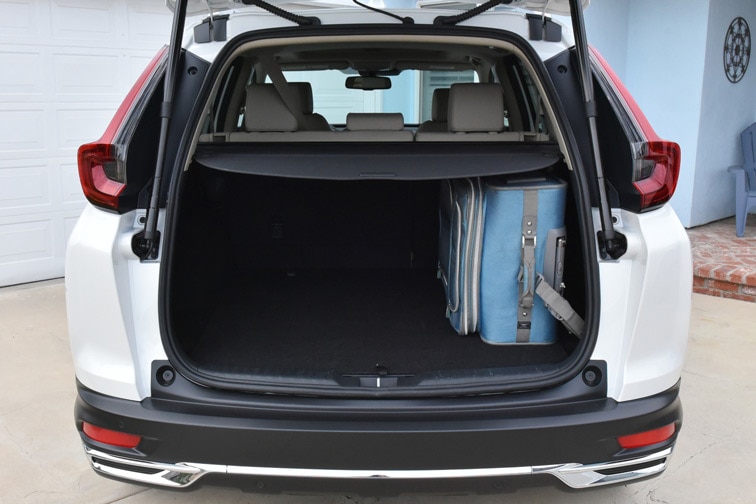 Christian Wardlaw
Christian Wardlaw
COMFORT AND CARGO SPACE REIGN SUPREME
Honda gave the CR-V a styling nip and tuck for the 2020 model year and made no changes to the SUV’s looks for 2021. The interior remains the same, too, after Honda added a new storage console between the seats in 2020
Quality materials are the rule, with impressive consistency in surface gloss and grain levels throughout the interior. The test vehicle’s soft and supple ivory-colored leather stood in stark contrast against the black carpets and dashboard. Simulated wood decorates the cabin, but it falls short of emulating the real thing.
Honda lays out the controls logically, and aside from a missing radio tuning knob, you’re equipped with a layout you’d expect. The push-button transmission controls take some acclimation if you’re new to this kind of design.
Comfort is the highlight inside of a Honda CR-V. The front chairs offer excellent thigh and back support, and the driver can easily find a proper position behind the steering wheel. Softly padded material covers the center armrest, door panel armrests, and upper door panels. Outward visibility is equally outstanding.
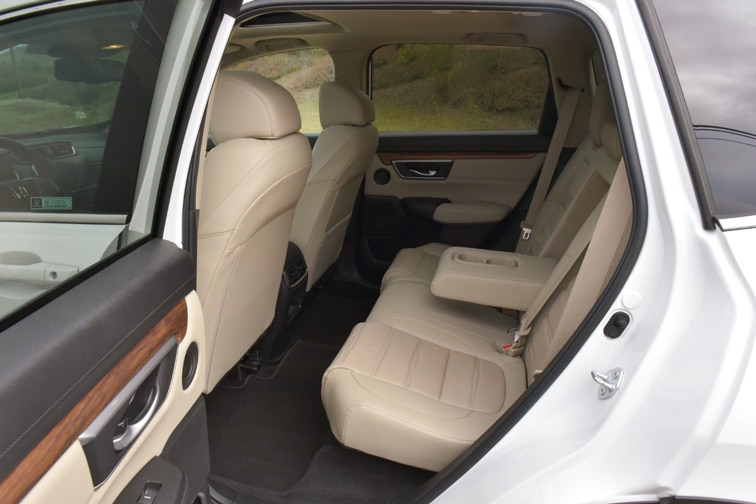 Christian Wardlaw
Christian Wardlaw
Open one of the CR-V’s rear doors, and you’ll find it swings out to a nearly 90-degree angle. This feature is helpful when using the CR-V to transport children who ride in child safety seats, but the CR-V’s rear doors are relatively long. The length can also hamper access when neighboring vehicles are parked close to the SUV.
People of all ages could find the CR-V’s back seat accommodating, and the amount of space feels on par with a five-passenger midsize SUV. A nearly flat rear floor makes it easier to use the center seating position. The CR-V Touring’s back seat has air conditioning vents, 2.5-amp charging ports, and a wide center armrest with cupholders.
Interior storage space is generous and practical, especially the sliding multi-compartment center console bin and large glove box. The cargo room is among the best in class. The CR-V supplies a total of 39.2 cu. ft. of volume behind the back seat and 75.8 cu. ft. with the rear seats folded down. Loading is easy thanks to a low liftover height, and full-size suitcases can fit on their sides underneath the cargo cover.
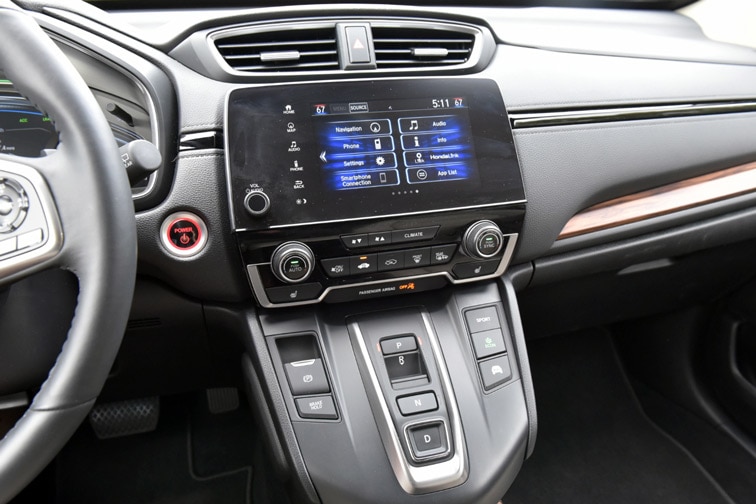 Christian Wardlaw
Christian Wardlaw
DATED INFOTAINMENT SYSTEM, AVERAGE DRIVING ASSISTANCE TECH
Generally speaking, one would never guess the Honda CR-V’s design and engineering dates back to the 2017 model year. However, the infotainment system gives away the CR-V’s age. Compared to the segment’s technology leaders, the appearance, capability, and operation of the infotainment technology is dated.All versions except for the base LX have a 7-inch touchscreen display, smartphone connectivity for calling and music streaming, wired integration to mirror popular smartphone platforms, text-messaging support, and a basic connected services plan. The EX trim level adds high-definition and satellite radio. The Hybrid EX features a total of eight stereo speakers while Touring trim installs navigation, wireless smartphone charging, and a premium nine-speaker sound system.
Although the CR-V’s infotainment system checks off most boxes on a shopper’s want list, it no longer represents sophisticated technology. For example, the voice recognition system is clunky, incapable of understanding naturally spoken requests, and even fails to interpret some commands when the driver follows the recommended voice prompts.
Additionally, the system displays one data panel at a time. For example, you can’t run the navigation map at the same time as the radio display. The connected services plan can’t match the best ones offered by competitors in the segment, and the smartphone integration technology isn’t wireless. This is not an exhaustive list; there were other obstacles we experienced in the test vehicle.
Honda needs to take this SUV to the next level when it comes to its infotainment technology. As it is in the 2021 Honda CR-V, the system is most satisfying in terms of the Touring trim-inclusive premium sound system. The sound quality doesn’t disappoint.
Concerning safety technology, the CR-V offers a more sophisticated package of equipment. Honda Sensing is standard and refers to a collection of advanced driving assistance systems (ADAS) designed to prevent a collision or reduce the impact of a crash.
Honda Sensing includes the following features:
- Adaptive cruise control with low-speed follow
- Forward-collision warning
- Automatic emergency braking
- Lane-departure warning
- Lane-keeping assistance (Honda calls this Road Departure Mitigation)
- Lane-centering assistance (Honda calls this Lane Keeping Assist)
- Automatic high-beam headlights
Choose a CR-V with EX, EX-L, or Touring trim, and it will have a blind-spot and rear cross-traffic warning system.
Honda Sensing’s adaptive cruise control and lane-centering assistance systems create a Level 2 hands-on semi-autonomous ADAS. However, it is not as effective as similar technology available from some competitors.
For example, during testing the Level 2 function could not successfully round a bend in a freeway with a light hand on the steering wheel. Any situation in which the right lane marking suddenly disappears, like for off-ramps and on-ramps, can easily disrupt the ADAS and lead the CR-V astray..
Also, while traveling on a freeway and climbing a mountain grade, the adaptive cruise control allowed the CR-V Hybrid’s speed to drop by 8 mph before accelerating to resume speed. This turned the SUV into a rolling traffic cone in the process; it’s the last thing you want as you start driving the SUV up a hill.
Positive notes about the Honda SUV include quick resumption of your set speed when traffic ahead clears. When another vehicle cuts into the gap ahead, the adaptive cruise control doesn’t unnecessarily or suddenly brake, either. It smoothly performs distance maintenance.
Generally speaking, Honda Sensing is effective. It is not as good as some, but it is better than others.
When it comes to crash-test ratings, the CR-V earns a “Top Safety Pick” rating from the Insurance Institute for Highway Safety (IIHS), but only when the SUV has Touring trim. The Touring version’s headlights perform the best, according to the IIHS.
The National Highway Traffic Safety Administration (NHTSA) gives the 2021 CR-V an overall 5-star rating.
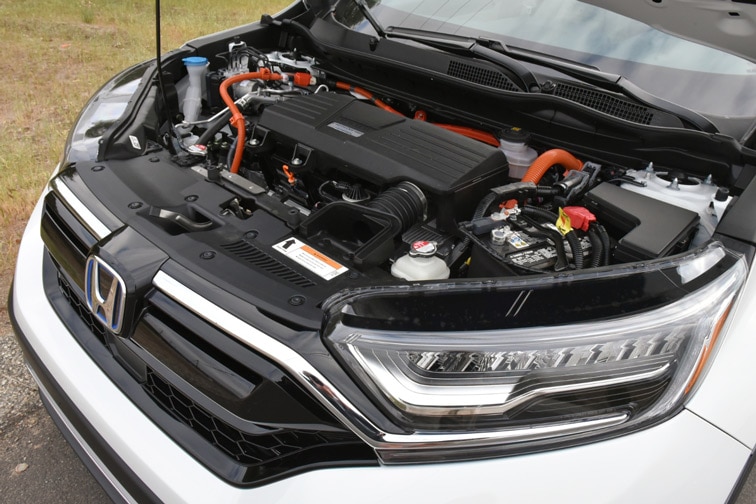 Christian Wardlaw
Christian Wardlaw
OFFICIAL FUEL ECONOMY ESTIMATES ARE OPTIMISTIC
A turbocharged 1.5L four-cylinder engine is standard in the 2021 Honda CR-V. It makes 190 hp at 5,600 rpm and 179 lb.-ft. of torque between 2,000 rpm and 5,000 rpm. A continuously variable transmission powers the front wheels unless you opt for all-wheel drive (AWD).
The CR-V’s standard engine is satisfying, but in exchange for a $1,200 premium, you can get the more powerful and efficient CR-V Hybrid, which comes with standard AWD. If you’re leasing or getting a front-drive model, you may not want to pay extra for the hybrid. But $1,200 compared to a turbocharged CR-V AWD could be worth considering for the hybrid powertrain.
Hybrids have a 2.0L four-cylinder gas engine, an electric motor, and an electric transmission. Total system hp measures 212, or 22 more than the turbocharged CR-V. That’s only part of the story. The electric motor supplies instant torque when you step on the accelerator, helping to make the CR-V Hybrid feel lively when accelerating from a stop.
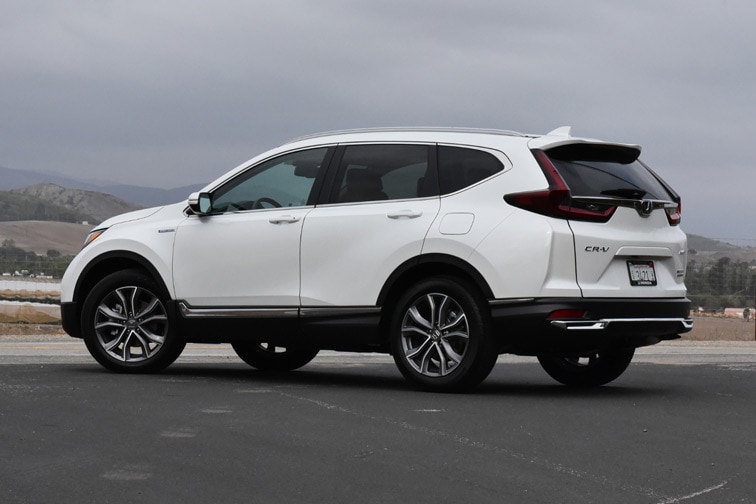 Christian Wardlaw
Christian Wardlaw
Drivers can choose between Econ, Sport, and EV driving modes, and there are apparent differences between them. For example, in Econ mode, the CR-V Hybrid feels slower, and the climate control system is less effective. In EV Mode, you can whir around on electricity at lower speeds. And in Sport mode, the CR-V Hybrid feels more athletic and responsive.
You don’t need to plug this SUV in to recharge the battery. Regenerative brakes (regen) and energy recuperation systems recharge the battery as you drive. Honda also provides regeneration paddles on the steering wheel to give the driver control over how much regen the CR-V Hybrid supplies.
On the testing loop in the car provided for this review, the CR-V Hybrid averaged 33.7 mpg. That’s well short of the Environmental Protection Agency’s official rating of 38 mpg in combined driving. Temper your expectations.
Overall, the CR-V Hybrid is pleasing to drive. It weighs 194 lbs more than a standard CR-V AWD, and that weight is compressed down low in the chassis. A perceptive driver with experience in both versions of the SUV can sense it more than others.
Nevertheless, on rumpled, uneven pavement like a rural two-lane highway, the CR-V Hybrid’s ride quality doesn’t feel as smooth and composed as the standard model. The added weight low in the SUV’s chassis helps to lower its center of gravity, improving handling. Yet still, the CR-V Hybrid emphasizes the “utility” part of the “sport/utility” equation.
Acceleration is quick due in part to the immediate torque supplied by the SUV’s electric motor. When driving at low speeds in EV mode, the CR-V Hybrid emits a futuristic whirring sound to warn pedestrians that an electric vehicle is driving nearby.
The CR-V Hybrid’s steering feels a little heavy at higher speeds, but as the SUV slows down the effort levels lighten up considerably. It’s easy to park this vehicle and maneuver it in tight quarters.
A hybrid’s regenerative braking system can often make the brakes feel grabby as you bring the vehicle to a stop. That’s not a problem in the CR-V Hybrid, but the amount of braking action you receive does not correspond to the amount of pressure you’re applying to the pedal. In other words, you need to push harder on the brake pedal than you might expect.
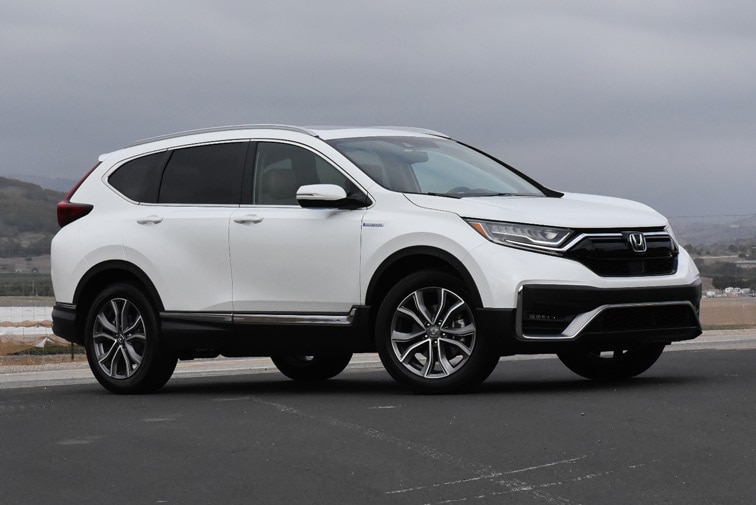 Christian Wardlaw
Christian Wardlaw
POPULAR FOR GOOD REASON, BUT IN NEED OF SOME REDESIGN
The Honda CR-V Hybrid is one of a handful of hybrid-powered compact crossovers. Others include the Ford Escape Hybrid, the Hyundai Tucson Hybrid, and the Toyota RAV4 Hybrid. However, all three of those competitors offer a plug-in hybrid variant in addition to gasoline and hybrid powertrains.
Furthermore, all three of those competitors offer more advanced infotainment and driver-assist technology, like the Hyundai.
Fans of the Honda CR-V need not worry. A redesign is close to final, with the next-generation version of the SUV likely arriving for the 2022 or 2023 model year. It may continue to improve in terms of technology and match key competitors in terms of electrification options.
In the meantime, with few exceptions, the 2021 Honda CR-V is an excellent choice in a compact crossover SUV, lacking nothing more than a sophisticated infotainment system to fully satisfy an owner.
Written by humans.
Edited by humans.
 Christian Wardlaw
Christian WardlawChris says his first word was "car." For as long as he can remember, he's been obsessed with them. The design. The engineering. The performance. And the purpose. He is a car enthusiast who loves to drive, but is most passionate about the cars, trucks, and SUVs that people actually buy. He began his career as the editor-in-chief of Edmunds.com in the 1990s, and for more than 30 years has created automotive content for CarGurus, J.D. Power, Kelley Blue Book, the New York Daily News, and others. Chris owns Speedy Daddy Media, has been contributing to Capital One Auto Navigator since 2019, and lives in California with his wife, kids, dog, and 2004 Mazdaspeed Miata.
Related articles
View more related articles